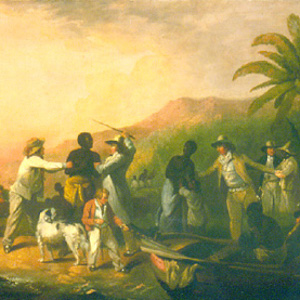Early Modern (1450 CE - 1800 CE)

Destruction of the French Colossus
This hand–colored engraving, published in late 1798, depicts a Hercules representing France being decapitated by a lighting bolt in divine retribution for the executions by guillotine and for the attempt to create "Fraternity" and a "Religion of Nature" to replace the Christian love of God.

The Contrast, 1793 British Liberty/French Liberty
In this color print from 1793, the height of the Terror, two circular drawings appear next to each other, contrasting two types of liberty. English liberty exists, as the figure suggests, but based on the Magna Carta, calm prevails.

Promised Horrors of the French Invasion
This highly sophisticated political cartoon by the noted engraver James Gillray from October 1796 responds to Edmund Burke’s pamphlet, "Reflections on a Regicide Peace." This image argues against further war with France to avoid bankrupting the British treasury and exposing England itself to inva

Britannia Rules the Waves!!
This color drawing from 1798 mocks both the French navy’s abysmal performance against Nelson’s fleet and the French hope to invade England; in the style of Gillray, it depicts a grotesque, gargantuan woman, straddling the English Channel and urinating into French ships while her trident pierces F

Day of Saint-Cloud
The problems of the revolutionary government had so intensified that the two leaders, Abbé Sieyès and Roger Ducos, plotted to overthrow it with the help of the most famous military man of the day. But the legislative body, particularly the lower house, proved resistant.

Scene of Directory Life, Men and Women from L’Optique du Jour
After Jacobin control faded, with its repression of exuberant social life as well as political diversity, the following years saw a rebirth of open pleasures. This image focuses on fashionable men and women enjoying the good life.

Execrable Human Traffick, or The Affectionate Slaves
This reproduction of a painting by George Morland (1789) has lurid colors and shows the sale of an enslaved person.

Bonaparte, First Consul of the French Republic
From the beginning it was clear that Napoleon’s political support was closely tied to his fortunes in war. This engraving celebrates the victory over the Austrians at the battle of Marengo in Italy, June 1800.

Image of the King’s Departure
This engraving depicts the King, his wife, and his children meeting at half–past midnight on 21 June 1791, about to board a carriage in which they will flee secretly from Paris toward the border. The King and Queen were poorly disguised as servants to a German noblewoman.

Return from Varennes, Arrival of Louis Capet in Paris
Following his arrest, Louis and his family are returned to Paris. Large, silent crowds looked on disapprovingly.